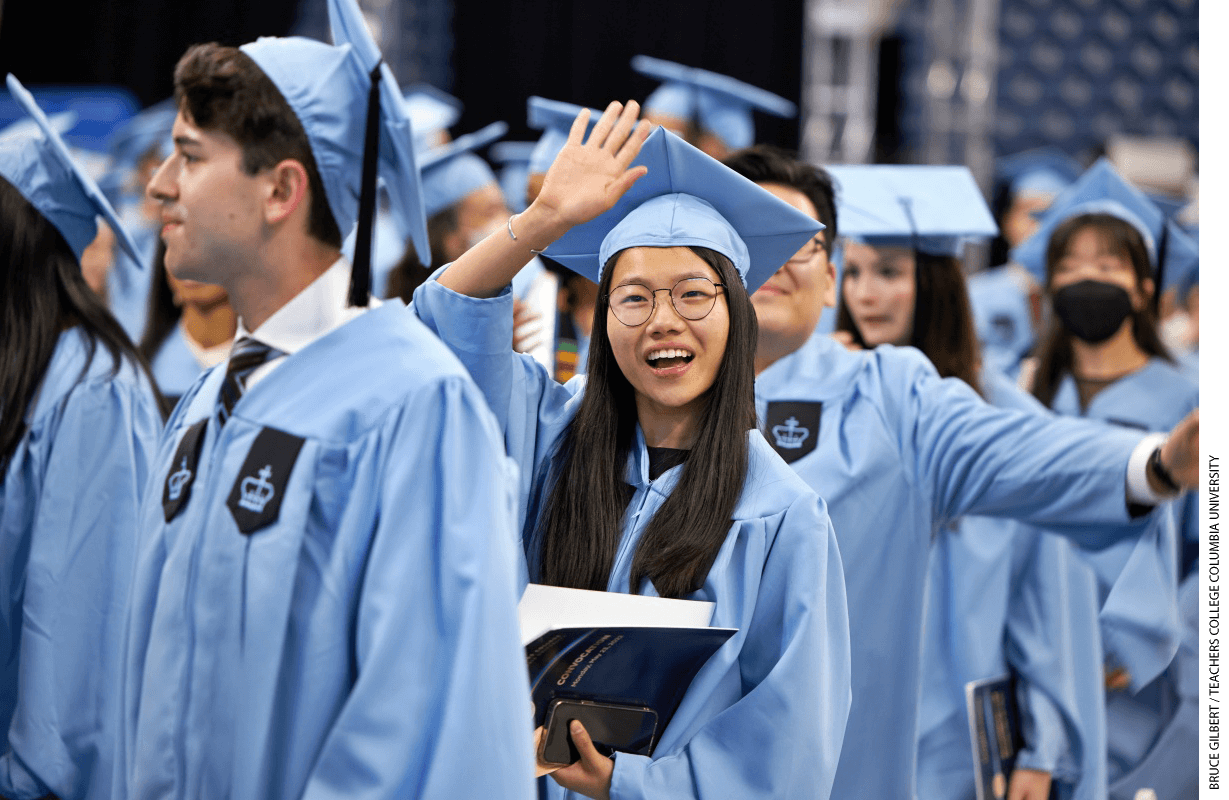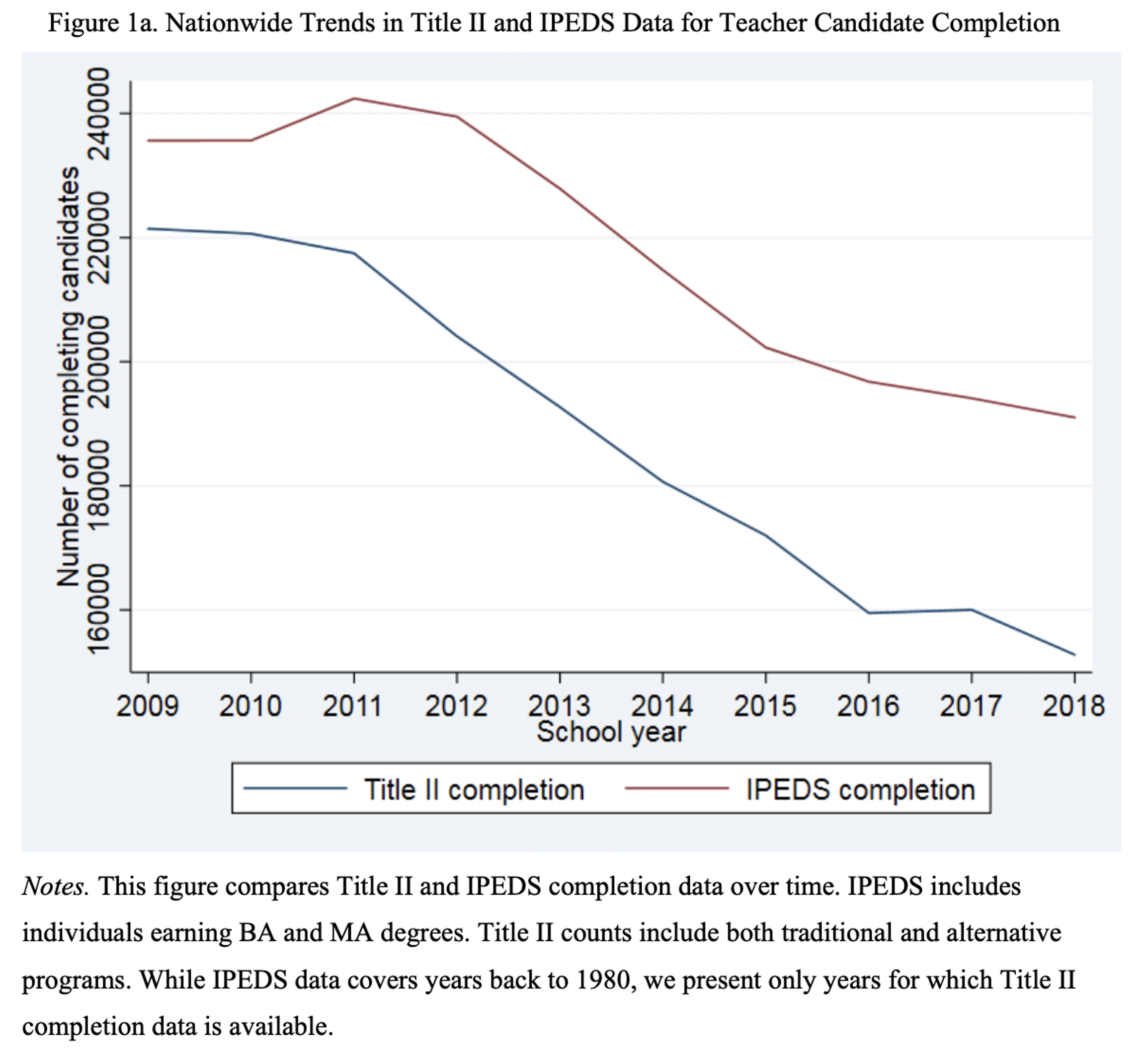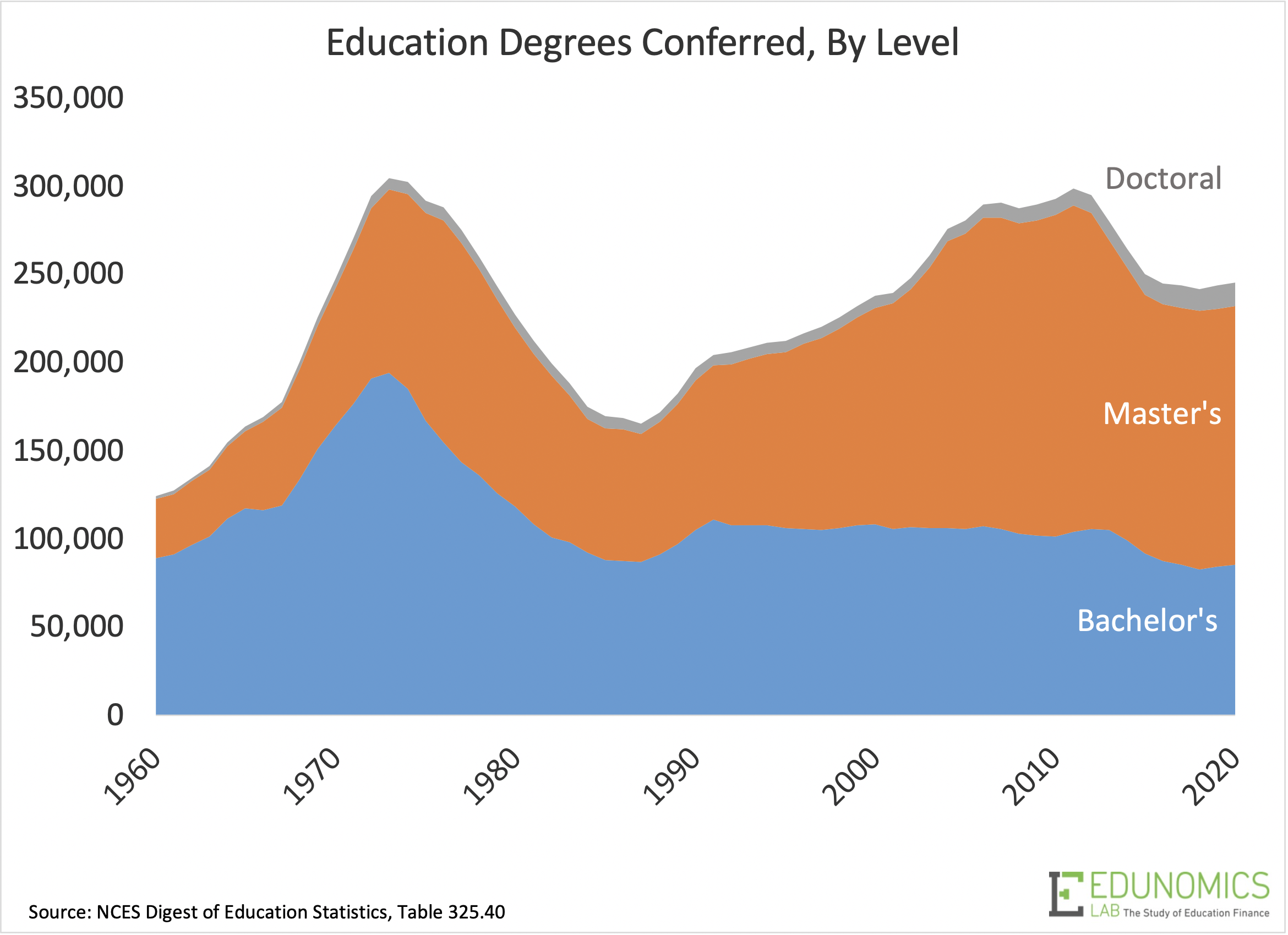
The competition for labor has never been more intense. Employers have more job openings than ever before, and there are fewer potential employees to fill those roles. The unemployment rate is near pre-pandemic lows, and there are few working-age adults who are not already employed.
These labor problems are hitting schools particularly hard. Even flush with a surge of federal dollars, districts simply can’t hire as many people as they would like to.
The supply of new teachers is also down significantly. Depending on the data source, there are 20 to 30 percent fewer people going into teaching each year than there were a decade ago. Those numbers are not likely to rebound quickly.
What caused the decline in teacher-preparation enrollments and completions? Until we diagnose the problem accurately, we won’t be able to devise solutions to fix it. To that end, I offer a few theories below and attempt to unpack how much truth there is behind each one.
What does the data say?
Whichever theories we have for the decline in teacher-preparation completions, they need to fit the facts. We know that teacher-preparation enrollments and completions are down, but by how much, and when did the declines start?
As Dan Goldhaber and Kris Holden describe in a 2020 CALDER brief, there are two main data sources used to understand the supply of new teachers: Title II reports and the Integrated Postsecondary Education Data System.
Title II reports are collections from states and the U.S. Department of Education that capture the number of people enrolling in teacher-preparation programs and earning teaching certificates. This data includes traditional preparation programs at colleges and universities, as well as alternative preparation programs, which may or may not be housed at colleges and universities. The Title II data only go back to the early 2000s, though, and cannot be disaggregated by gender or level of degree awarded.
In contrast, the Integrated Postsecondary Education Data System tracks the number of people completing college degrees by level and by major. Annual data goes back to 1960, and it can be broken down by type of degree and by gender. There are some people who earn college degrees in education but do not pursue teacher licenses (let alone new ones), however, and there are some people who earn teaching licenses outside of colleges and universities.
Still, the patterns across the two data sources look remarkably similar. Here’s a graph from the Goldhaber and Holden brief showing the number of completers according to data from Title II (in blue) and from IPEDS (in red).

The Goldhaber and Holden piece came out in 2020, and we now have a bit more data and nuance to add to the story.
First, both Title II and IPEDS data were starting to show a slight uptick in the years leading up to the pandemic. The gains weren’t large, but they did reverse a multiyear trend, and any explanation for the decline in the supply of teachers must take this into account.
Second, the Title II data shows that all of the decline in the supply of new teachers came from traditional preparation programs at colleges and universities. From 2013 to 2019, the number of individuals who completed traditional preparation programs fell by 29 percent, while it rose by 18 percent for alternative-route programs, which tend to be shorter and cheaper (See Table S1.4 here.) Traditional programs still prepare about 3.5 times as many new teachers as alternative-route programs, but any theory attempting to explain the broader decline in the supply of new teachers has to explain the differences across program type.
Third, the demographic composition of those pursuing a career in teaching has changed over time. The profession has become even more dominated by women. Additionally, while fewer people are pursuing bachelor’s degrees in education, we now confer about twice as many doctorates in education per year as we did two decades ago. This is at least suggestive evidence that there are fewer people who want to try teaching but more people who are dedicated enough to stay and reach the highest levels of the profession. That distinction is important when we get to theories for the decline in new candidates.
Fourth, we’ve had declines in the supply of new teachers before. We actually had a much larger one in the 1970s and 80s. The graph below shows the long-term trend in education degrees from the IPEDS data. Bachelor’s degrees in education are represented in blue. They reached a peak in 1973 and have never returned to that high.
Master’s degrees in education are represented in orange. This data can’t disentangle who is choosing to pursue a master’s to improve their skills or earn higher pay from who is essentially required to earn a master’s degrees in order to enter or remain in the profession. But we do know that, over time, states have built up more requirements for who can enter and remain in the teaching force, pushing a much higher percentage of incoming teachers to earn master’s degrees. As we’ll see later, higher barriers to entry can have a meaningful effect on the number of people who choose to enter the teaching profession.

The most recent downtrend in the 2010s looks almost mild in comparison to what happened in the 1970s and 80s. Starting in 1974, the number of people completing a degree in education fell by 46 percent. After 14 straight years of declines, we had 140,000 fewer people earning education degrees in 1987 than we did in the peak year of 1973.
Contrast that earlier decline with the 19 percent dip we saw more recently. We experienced seven straight years of declines, with 57,000 fewer education degrees awarded in 2018 than were awarded in 2011.
This pattern is what I’m concerned about today. Why did it happen? What caused it, and what would get the numbers back up?
Note that we’re talking about national totals here, but that’s not how the teacher-labor market works in practice. Districts don’t need to hire a generic teacher; they need to hire individual candidates with specific licenses to fill particular roles. Even in today’s tight labor market, district leaders report having a much harder time filling special education and STEM positions than they do filling elementary or social studies positions.
Some people may be inclined to guess as to what’s happened to the supply of new teachers since the pandemic. On one hand, it’s possible fewer people went into teaching because they didn’t like the transition to virtual learning or didn’t feel comfortable in schools. But it’s also possible more people entered teaching thanks to states’ temporarily waiving or permanently reducing their licensure requirements. We don’t know yet. For now, all of our objective data ends with a slight uptick in 2020, so our theories need to fit this fact pattern.
Theory #1: Covid-related changes have made teaching less enjoyable.
Theory #2: Book bans, the fight over CRT, and culture wars have made teaching more political.
I’m going to take these two together and declare them FALSE. Simply put, they don’t fit the fact pattern described above. The decline in teacher preparation occurred before we had even heard about the novel coronavirus we now know as Covid-19.
The culture war issues can’t explain the biggest declines from 2013 to 2015 or the slight uptick in our most recent data (2018–2020). They also don’t fit with the discrepancy between traditional and alternative-route programs. It’s plausible these issues could exacerbate an already tight labor market going forward, but we don’t have good evidence either way on that yet.
Theory #3: Respect for teachers has declined, which reduced the supply of potential candidates.
This is a hard concept to define, but I’m going to rate this one as FALSE as well. The main data point used to back this claim is what used to be known as the MetLife survey and is now the Merrimack College Teacher Survey. While it does show a decline in teacher satisfaction, the survey questions have changed over time, making it impossible to make long-term comparisons.
Meanwhile, Gallup’s annual rating of the honesty and ethics across professions continue to show teachers as one of the more-respected occupations. According to their poll results, respect for grade-school teachers was steady from 2010 to 2017 before hitting an all-time high in 2020. It did take a slight dip in 2021, driven by a notable downturn in positive ratings among self-identified Republicans, but none of that fits with the trajectory in the supply of new teachers.
Theory #4: Starting salaries are too low to attract new teachers.
As recent data from the National Education Association show, teachers’ starting salaries really did lose ground to inflation from 2011 to 2018, and they were starting to grow faster leading up to 2020. This fits the fact pattern.
However, I rate this one as MOSTLY TRUE because we don’t have good empirical evidence linking teacher salaries with the supply of teachers. It’s certainly likely to have an effect, but it would be nice to have more-precise estimates of how much a change in starting salary would affect the supply of new teachers.
Still, this theory bodes poorly for the coming years. Teacher salaries tend to be sticky and trail the broader economy. As inflation has risen rapidly over the last year, teachers’ starting salaries have not kept up. That could put a damper on the number of new candidates who want to enter the profession in the coming years.
Theory #5: Newly erected barriers have made it harder and less desirable to teach.
You may not remember it now, but, during the Obama Administration, there was lots of talk about “raising the bar” on the teaching profession by making it tougher to become a teacher. The agencies that accredit teacher-preparation programs merged together and adopted tougher standards for who could enter their programs by adopting higher GPA and ACT/ SAT score requirements, among other measures.
Around the same time, 18 states adopted a new, more-rigorous teacher-licensing test called the edTPA in the hopes that it would do a better job of screening out ineffective candidates. When researchers at the University of Illinois looked into how the adoption of the edTPA affected the supply of new teachers, they found that it “reduced the number of graduates from teacher-preparation programs by 14 percent.”
In 2010 and 2011, states also enacted a number of other teacher reforms, such as implementing tougher evaluation systems, more rigorous bars for tenure, and new licensure exams. A paper by Matt Kraft and colleagues found that these “accountability reforms reduced the number of newly licensed teacher candidates and increased the likelihood of unfilled teaching positions, particularly in hard-to-staff schools.”
These reforms might have been worthwhile if they scared away some teachers who would not have been effective in the classroom, but I’d rate the barriers-to-entry theory as MOSTLY TRUE for explaining the decline in the total supply of new teachers. It has some solid empirical evidence behind it, but the timing is conflated by other factors, and it doesn’t explain the slight increase in recent years.
Theory #6: Broader economic trends have pushed would-be candidates into other fields.
The number of people completing degrees in education has gone down over time, but it’s down by a similar rate as the number of people completing degrees in ethnic, cultural, and gender studies; English language; foreign languages; and library science. In fact, some of the biggest changes over the last decade have been in relation to the decline in the number of people completing degrees in broader liberal arts and humanities programs.
I’d rate this theory as TRUE. Rather than being an outlier, education fits well within the broader societal patterns. Over time, people have chosen to study business, nursing, and computer science and other STEM fields at the expense of the humanities, including education.
What’s next? And what can policymakers do?
Based on the timing and the magnitude of the declines in new teacher candidates, I think it’s fair to give partial credit (or blame?) to three main factors: low starting salaries, tougher barriers to entry, and broader economic trends. State and local policymakers can do little about the macroeconomy, but they do have authority on the other two factors.
First, if policymakers are worried about teacher shortages, they should really focus on starting salaries. Starting salaries are the most likely factor to affect potential candidates. Teacher turnover is highest among teachers in the early stages of their careers. And yet states like Alabama and Mississippi recently adopted eye-popping pay raises for the longest-serving veterans. Boosting starting pay may have been a better bet to improve recruitment and retention rates.
District leaders should be looking at their specific shortage areas. If they suffer from chronic shortages in certain schools or struggle to staff special-education and STEM roles, they may want to revisit their compensation packages. Over the last two years, we’ve seen a number of districts adopt flat-dollar incentives to address their longstanding recruitment and retention issues. Districts struggling with staffing shortages in specific areas may want to consider similarly targeted approaches.
State leaders are already considering modernizing their licensure requirements. First we saw it during the pandemic with the requirements for new teacher candidates, then states started to drop requirements for who could be a substitute teacher. More recently, New York decided to drop the edTPA over concerns it was reducing supply and harming diversity efforts. Will we see more of this?
Some people are concerned about teacher quality suffering, but it could be a good thing if states are eliminating entry requirements that do not have a strong link to effectiveness. The current requirements keep out some promising candidates but have little value in predicting who’s going to become a good classroom teacher. Instead, states could give more autonomy to districts to select their own teachers at the front end, while requiring teachers to demonstrate effectiveness in order to qualify for more permanent, advanced instructional roles.
Districts may not control the licensure requirements for teachers, but they do determine what types of educational credentials they need in other roles. With the unemployment rate for college graduates near all-time lows, districts will need to think carefully about their labor needs. Can they change who they consider for their job openings, which might mean potentially lowering their educational requirements? Will they partner with students or families to play a more active role and fill some of the district’s labor needs, as some districts have done already?
The issues are complicated, and it’s tempting to craft a narrative based on what’s hot in the news today. But it’s important to align our story with the actual facts on the ground. The data is pointing to actionable steps for policymakers, if they’re willing to listen.
Chad Aldeman is policy director of the Edunomics Lab at Georgetown University.


